Small Business

Miami is not one of the places I would have thought about spending the day honoring Saint Patrick. I remember it traditionally as a raw early Spring day up north, with luck accompanied by some sun and a light jacket, and without luck, gray and wet both inside and out.
In Chicago they have turned the river green with dye; looking down from the tower of the Hilton, I can imagine the Biscayne Bay far below shimmering green. I will give you the complete forecast for the week in just a few words: “partly sunny, 81.”
I was crashing through a bunch of stuff to get the conference business wrapped up. The Government was remarkably forthcoming about all sorts of stuff, and had paraded a whole bunch of experts to explain the social goals contained in the Federal Acquisition Regulations, the famous FAR. They even had a witty and earnest man from the SBA there to tell us about an energetic new policy approach to woman-owned, minority-owned, HubZone and Service Disabled Veteran-owned activities.
It all sounded sort of complex, but I have alway felt that compliance with the Government’s social goals made for a more competitive product. They seem to take this seriously, and consequently, I do, too.
The culmination came with what was billed as a “Forecast to Industry: The Road Ahead,” and I was afraid that there would follow a bunch of platitudes and not much substance. I was pleasantly surprised to find I was wrong.
Karen is probably the hottest senior executive in the Acquisition Community, and she did most of the reading, and I scribbled frantically. Her briefing walked through the usual boilerplate but then began to address some real meat.
She literally drew gasps from the crowd when she described one of the contract vehicles for information technology as being worth more than six and a half billion dollars. Then she began to talk about the follow-on contract to the one I am working as being well over $5 billion.
There are nearly thirty separate contracts with values in excess of $100 million dollars, so the vast ballroom became remarkably silent in anticipation.
Karen said that they are submitting their plan next week to Frank, who is Principle Deputy Director for Acquisition, Technology and Logistics to ensure compliance with the FAR, and to ensure that Small Business gets a slice of the pie.
I will be interested to see how that works out. I closed my notebook and walked out of the hall, passing small knots of clearly not disadvantaged people who were scheming to cut up the pie in entirely new ways.
Considering that I am so apprehensive about the markets, and the impact of the Japanese disaster, I don’t know if I am living in science fiction or fantasy. But it is OK.
I had to smile at the unreality of the whole enterprise, but this is the way it works.
I had an idea of how I was going to do it, and walked toward the pool deck to get some late afternoon rays.
As they say, “Game On!”
Copyright 2011 Vic Socotra
www.vicsocotra.com
Quinn’s on the Beach
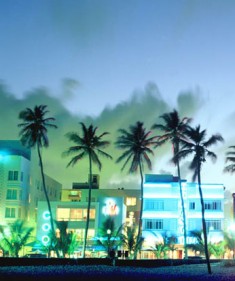
Quinn’s Restaurant on Ocean in Miami’s SoBeach. Photo Quinn’s.
They say what goes to Vegas ought to stay in Vegas.
Normally, I am in complete sympathy with that approach. After all, the innocent should be protected, and the wicked should be left where they can be scourged on their own account. But this was innocent enough, and besides, you don’t know Tom, a swell guy from one of our rival companies, who may (or may not) enjoy a tot or two as solace on the road.
This conventioning life can be an existential one, and he is one of the gentlemen of the road. Or maybe I should just say that something like this might have happened at some other conference in some other resort town. Yeah. That’s it. In fact, never mind. The two working ladies were proper enough, though the fact that they were drinking Diet Cokes should have been at least a partial tip-off, and the fact that the House Dick had to drag Joe off to pointedly ask if the ladies-in-question were his guests another. We had all got quite past that, though Joe and my associate were discussing the matter up the table at Quinn’s in SoBeach.
You can look it up: “Tucked beautifully into the hip Park Central, one South Beach’s most charming art deco hotels, the stylish eatery is a hub for fabulous people-watching amidst soothing live music, swaying palms, balmy breezes and the velvet darkness and salt tang of the beach. “
A black 1940 Ford coup with a mannequin in a slouch hat at the wheel was parked at the curb; actually, we were all at the curb, at a table for fourteen in the open air on the sidewalk in front of the restaurant proper.
We were at the edge of the SoBeach evening promenade, a walk of extraordinary diversity that resembles nothing I have seen in this merry wobbling world. The prettiest of ladies, the buffest of men, small dogs, ancient tourists, flat-brimmed gangsta ballcaps on rolling perp walk struts flowing past. It was all there jiggling, an undeniable current of raw and vital life just inches from our long table.
There were multiple trips in a variety of vans and cabs to bring the group to this place, and I have no idea how Joe picked it. A trip to the restroom suggested to me that the place might have been a bank back in the days before the big Miami beach real estate bust, the one that pre-dates our recent national melt-down, and is the antecedent of the next one.
I had been fairly well concerned about that when I was seated listening to General Hugh Shelton, the 14thChairman of the Joint Chiefs of Staff at the conference that morning. He is well preserved, as you might expect, and has a new book out about his impressive military career. The General specializes in motivational speeches these days, and he is quite good at it. As I listened, I scrolled through a disturbing e-mail from one of my correspondents.
I was trying to keep tabs on the disaster at Fukushima Daiichi, and I was gratified to see that it appeared the Japanese engineers were going to prevail, with dauntless courage, over the melting refined uranium.
The other news was as bad, and there were no heroes in it. The long analytic peice was about the tsunami of debt that the Fed is valiantly pumping into the economy, to the tune of $4 billion a day. We have gotten quite used to these astonishing numbers, and the commentary goes like this: The Fed will cease this “Quantitative Easing” thing sometime in the summer because the smart guys are getting nervous. The market, which has artificially been pumped up with the funny money, will collapse. A new QE will quickly be re-imposed, but the genie of inflation will be out of the bottle again.
What was curious is that the smart guys cannot tell me if this is the deflation of Japan’s collapse of the 1990s, or that of Weimar Germany’s hyper-inflation in the 1930s.
The only thing to do as the conference ground on through the day was to go to dinner. It was our equivalent of doing what Mr. Bernanke is doing.
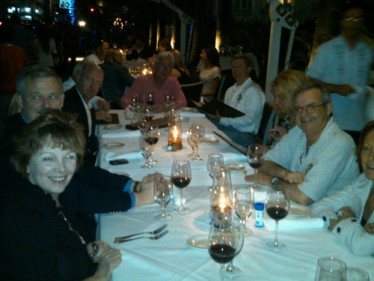
Some people I don’t know at Quinn’s, in Miami’s SoBeach. Photo SAIC.
An extraordinary performance artist was working our table. Dark-eyed, lean, Latin and approachable, Ricardo juggled wine-bottles and menus with aplomb. He was supervised by award-winning executive chef and owner Gerry Quinn, who made a special trip from the kitchen to introduce himself to our Quantitative Easing party.
Gerry is committed to redefining “local flavor,” we were told. He fuses old-Florida style seafood concepts with progressive global trends. The result is a South Beach seafood institution that you really ought to take in, if you have a chance. I had the calamari salad and the sashimi tuna, and it was dynamite.
I would tell you more about what happened at Ocean Drive, but I think I have been indiscrete enough. Suffice it to say, if this all melts down this summer, it was still one hell of a good dinner, and it might define, in my mind, what is going to look like our Gilded Age when we look at it in the rear-view mirror.
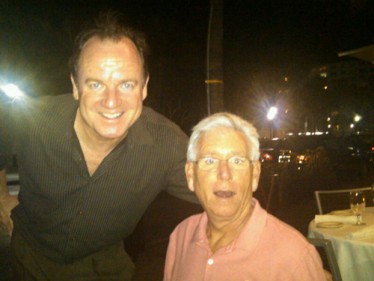
Executive Chef and owner, Gerry Quinn and some gape-mouthed tourist. Photo SAIC.
Copyright 2011 Vic Socotra
www.vicsocotra.com
Fukushima Daiichi

Satellite image of the Fukushima reactor complex. “East,” toward the Pacific is actually oriented toward the top of the image. Photo by DigitalGlobe via Getty Images
There are Ides of all the months, so unless you are Julius Caesar, I would not worry about it this morning. Or Muhamar Qaddafy, but he seems to have kept his self-esteem thing going pretty well, along with his attack helicopters and imported Taureg mercenaries.
I worry a bit about the Libyan rebels, since I have not met them, but certainly wish them well on this day.
I am in a Miami tower, darkness still cloaking the cruise ships at their berths, and there are other plenty of other things to worry about. Public places would be some of them.
Japan is an intensely public place. You know that is why the people of Dai Nippon are the way they are. The public face goes with the public place. This morning, they are worrying about radiation again, and my heart goes out to them. The melting rods of processed uranium are not the catastrophe of the bombs that we dropped on them, nor the hundreds of thousands of tons of conventional explosives that were required to bring the Militarists to heel.
The terms “meltdown” have been thrown around with abandon, and it appears that there are a couple of them in progress right now. The situation is dire, but not so bad as Chernobyl, they tell us, though maybe a little worse than the event at Three Mile Island.
What happened at the Fukushima Daiichi (Number 1) nuclear plant is bad. The reactor is a 1970’s Westinghouse design that requires coolant to be constantly circulated over the power rods.
The flood from the tsunami disabled diesel generators that power emergency cooling systems for five reactors at the plant and a nearby plant known as Fukushima No. 2 (Daini). Without power from the generators, the cooling system pumps cannot circulate cool water around the radioactive fuel rods. As a consequence, the water has boiled off and the fuel rods have melted, which may have caused an explosion and permitted a massive escape of radiation.
Radiation levels have risen to several multiples of annual recommended safety levels. Residents within twenty kilometers of the plant have been advised to lock themselves down and shelter in place.
The commentators are going wild about that, with the predictable results that some are saying that nations with seismic issues- America would be one of them- should not have nuclear plants based on the danger of disruption.
I am not going to worry about it this morning. The reactors that are having problems are ancient in age, and there is better technology that can be much more easily managed in times of crisis. But the relative truth of that will have little influence against the massive emotion caused by a major radiation leak.
We have worried about that, off and on, since 9/11.
The magnitude of the quake is still being registered. The earth’s axis has been changed, ever so slightly; the great island of Honshu has actually moved several feet on the tectonic plate on which it rests. Bizarre.
So, as I prepare to dress in an aloha shirt and linen slacks to descend to the conference to listen to earnest government folks talk about the problems confronting them and their industry suppliers, I am going to be taking surreptitious notes on the impact of the quake on the Japanese economy, and the inclination of Tokyo to continue to purchase US T-bills.
The Japanese are the second largest consumer of the financial instruments, the continued sale of which are propping up the sluggish recovery here.
Things go on because they must go on; plans have been made, and will be executed since it is more trouble to change than go ahead.
But sometimes events can cause the very earth to wobble on its axis.
I will put on my business face here in a second and head downstairs. But in the meantime, pray for speedy resolution of the immediate crisis; swift remediation of the contamination, and if you can, send help to those in need.
I don’t trust those who rush around in the aftermath of tragedy with their hands out, but I gambled on Mercy Corps when Haiti shook itself to pieces.
I will try them again. http://www.mercycorps.org/
Copyright 2011 Vic Socotra
www.vicsocotra.com
South Beach and Cuban Black Bean Soup
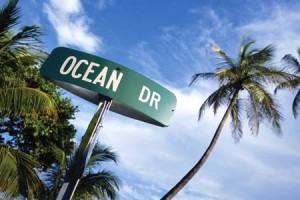
Miami’s SoBeach. Photo Socotra.
Oh man, I am actually out of the winter. It was painful, but I suppose all good things are. The clock folly- springing ahead- occupied the last padding around, forgetting the last minute things that I would realize I really needed a thousand miles away.
The time line to the flight changed markedly after losing an hour, but it was OK. Completely OK, once through security and the full body scan. It was not until our little party was seated in the waiting area that the news came across the wire that TSA had apparently no idea how much radiation they are pumping through us in the interest of safety.
We were wondering about the two reactors melting down in Japan. It was not funny- but it occurred to me that it was exactly something like this that caused Godzilla to wake from his eon-long sleep under the Sagami-wan and rise to scourge the home islands.
“Not to mention the awakening of Rhodan and Mothra,” noted my Associate.
“Destroy all monsters,” I said darkly, quoting the single greatest film ever made with a cameo appearance by Raymond Burr.
“It is only going to be a question of time before Global Warming is going to be associated with the volcanic activity, you know.” That was from Jeff, the CEO of a small company that just won a big contract and is in an enviable position.
“One thing is for sure,” said our Subcontracting Officer: “We are going to be dead a lot longer than we are alive. So live.”
That made a lot of sense. We were on a little jet, a regional fraud that masqueraded as a real airliner, and my seatmate appeared to not have dealt well with the time change, or was a junky. In any event, he flopped into the seat on the aisle, his leg slumped into my side of the painfully small seat, and his elbow draped on my side of the armrest.
Damn. But, I have to say, when we walked out of the jetway and the coolness was from air conditioning and not because someone left a window open things got better fast. Then the bags were there, delivered before we were, and although someone had stolen the rental car from the Hertz #1 Gold spot, they happily coughed up another piece of crap Camry and off we went.
It was sunny. It was blue. It was mesmerizing.
So what if the rooms were not ready? We wandered out by the pool and had a salad for lunch and began to sway in the breeze like the palms. Relaxed was the only way to put tit, all the tension leaking out.
A sweet fruit drink or two later and it was possible not to care at all. The rooms came through just after lunch was past, and we made our way back to the Hilton’s Concierge to collect the bags.
“Calle Ocho later?”
The young afro-Cuban man behind the desk coughed gently. “I live in the Gables,” he said, “right next to the Calle, and I have not been there in five years.” He looked delicately at us, as though trying to tell us about in infestation of sharks in a position consistent with civic boosterism. He settled on this: “I would suggest that if I was interested in safety, I would not put it high on my list.”
That was ambiguous enough a warning that the wild street festival of Calle Ocho dropped off the menu for family-style activities as we took the elevators up from the seventh floor lobby to get settled and changed in our rooms.
“South Beach it is, then. We can meet down here at four-thirty.”
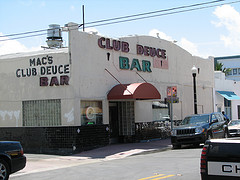
I wanted to get to the Club Deuce, the oldest dump bar in Miami Beach, a mere five miles away by cab from the downtown Hilton, but we only spent about thirty seconds in the place.
Two guys had lip-locks on each other at the bar, and that was grosser earlier in the day than some of us wanted to see, so we were leaving before all of us even got in.
“Argh,” said my Associate.
“Imagine that,” I said. “Homosexual activity in south Beach.”
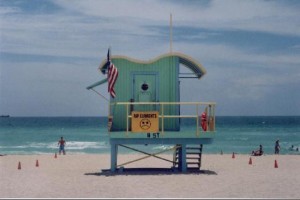
I was disappointed, but it turned out all right. There was more skin at the beach than you could imagine, and more of it on the street back from the artificial dunes, and colorful tattoo ink, and pneumatic bosoms, some real, and crazy souped-up candy-colored cars and strolling people of all colors and street cafes and dancers and a pulsing rhythm and the coolest art deco buildings and, well, it was South Beach.
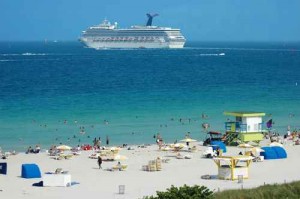
What an amazing tonic after a DC winter. Damn.
In honor of the Miami boondoggle, SuperMat made something Cuban back home. He is still a government guy and his shop would not come up with the travel money to let him attend this very official conference.
He said it was good on a cold and windy Sunday. I have to agree with assessment, but I am thinking about having some outdoors this afternoon, maybe in la Habanacita.
Somebody said we are dad a lot longer than we are alive, you know? And you know the strangest thing?
Muhammed-the-Irish-cabbie said exactly the same thing on the ride back from South Beach to downtown. This is very strange, and there are no coincidences, are there?
SuperMat’s Cuban Bean Soup

1 diced onion
1 tbsp minced garlic
4 cans black beans – rinsed
2 cans chicken stock
1 tsp cumin
1 tsp thyme
1 tsp oregano
2 or 3 smoked ham hocks (~2 lbs)
1 – 2 tbsp fresh lemon juice
Hardboiled eggs
Mix first 7 ingredients above in Crock Pot and top with smoked ham hocks
Set Crock Pot on low and cook for 7 hours
Remove ham hocks from Crock Pot and pull meat off the bones
Dice meat and return to Crock Pot
Stir in lemon juice
Serve in bowls and garnish with hardboiled egg.
Copyright 2011 Vic Socotra
www.vicsocotra.com
The Big Quake
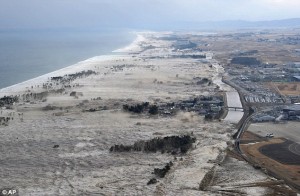
Coastal Honshu underwater. Photo courtesy of The Guardian
The effects from the devastating earthquake and tsunami in Japan are still
being assessed, and I am traveling this morning. It is pushing five thirty, and the ride to the airport is going to be here in twenty minutes.
I could tell you about the adventure of moving my son’s stuff to Virginia Beach, but life’s little travails are not of much account against real and amazing tragedy.
Accordingly, this is in the line of a guest column from my pal Kimo, and the photo is from the Guardian, forwarded by a great friend out west.
Here are some firsthand accounts from a few U.S. Navy Officers currently stationed in Japan.
From an officer in Misawa: “Everyone here’s okay. Lot’s of aftershocks. Crazy times. No power, heat or phones in region. We finally got our building generator working and rebuilt watch this afternoon (hence NIPR access). Working to support SAR/HADR ops…”
From an officer assigned to the GEORGE WASHINGTON Strike Group: “All safe here–thank you. Yokosuka NB military and families are fine and power is unaffected on base. Ikego lost power for a long time. It was interesting to say the least. Even as a Californian, the longest earthquake(s) I have ever experienced. The quake started gently but continued for what seemed like five minutes and grew in instensity. All staff–evacuated the building three times until we assessed the main quake(s) had passed. We continued to experience milder aftershocks through the night but no longer felt we had to permanently secure the watch and abandon the building. No apparent damage to the CNJF (Commander Naval Forces Japan) HQ building.”
GW was holding quarters in the hangar bay at the time the earthquake hit. An Officer onboard at the time of the quake said at first it felt like gear movement on the flight deck but then the whole carrier began to shake and it was then clear it was an earthquake. The GW moved causing the brows to have to be repositioned back; liberty was delayed for a couple of hours. Officers also reported that water level in Truman Bay had noticeably dropped by five feet.
Yokosuka NB remained in a tsunami warning until about 2100.
Interestingly, the earthquake caused a significant tidal action in the Purdy Gym pool causing complete flooding of that area. The rest of the gym was unaffected. A very interesting experience when you go from reacting to an earthquake to immediately having to seek higher ground because of a potential tsunami.
From another officer with Naval Forces Japan: “Here in Yokosuka we had two large temblors and many smaller aftershocks, but no significant damage or serious injuries or deaths. There were power outages on parts of the Miura Peninsula, but not onboard CFAY (Commander Fleet Activities Yokosuka). No USN deaths or serious injury that I have heard of. Plenty of HADR efforts starting last night.”
From a retired officer living south of Yokosuka Navy Base: “No significant damage on-base. Base, Honcho, Chuo, etc, maintained power. Heisei, Maborikaigan, Ikego & lots of other places lost power. Maborikaigan/our house got it back at 0106 this morning. Base ops are normal, although not sure if events were canx. The earthquake shut down the densha & tollways, so we had people walking home that took 3 hours or returned here to stay overnight. Cells still worked, but were clobbered.”
The reporting from NHK World continues to report that the two nuclear reactors in Fukushima Prefecture Power Plant have significant damage following an explosion on their Saturday. The back-up safety system (ECCS) has failed and they are putting sea-water into the reactor. The exact nature of the radiological leak is still unknown.
There are entire passenger trains still missing.
My thoughts this morning are of Japan, and with her people. More from Miami later.
Vic
The Wow Moment
Editor’s note: Management at The Daily is departing the building NLT 0645 this morning to support a Military re-location from Arlington to Virginia Beach. Accordingly, there will be no in-depth coverage of the mega-quake in Tokyo this morning, of which there may be $100 billion in damages, undetermined loss of life, and the spreading of Tsunami waves from the epicenter near Honshu across the Pacific.
Nor will we be adequately resourced to address the ferocious response of Colonel Qaddafy to the legitimate concerns of his people, nor the implications of the implication of imposing a No-Fly Zone across the Maghreb.
Management regrets the lack of personnel to throw at all the problems. The Domestic Desk has already been striped bare. With an impending deployment to Miami, it is possible that a disruption to regular Socotra distribution could occur.
__________________________
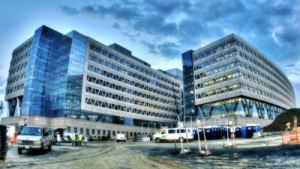
We piled out of the passenger elevator in the West tower of the New Campus East to begin a cascade tour down through the Command tower.
“First the Wow,” said Mylan as we turned left and emerged onto the glassed in-passageway that lines the inner edge of the west tower. Intricate etched lines break the otherwise transparent vista, and as a curtain of nothingness, the lines helped to avoid outright vertigo.
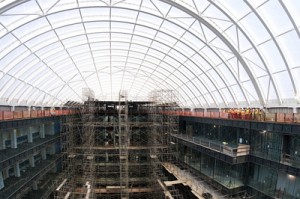
(We are at the Wow Moment in the tour, looking down eight floors to the floor of the Atrium, overlooking the exposed express elevators, and viewing the massive steel frame and ethylene tetrafluoroethylene, or ETFE, roof.)
“We calculate that the Stature of Liberty, less the base, could be placed on the food court and the Flame of Liberty would not penetrate the ETFE barrier.” Art smiled in satisfaction. “Or the Space Shuttle. A major kinetic event would only shred the roof, and not shower the atrium with glass. It also permits a much lighter framework to be used.”
“Wow,” I said, looking down and feeling a little dizzy. It looked like a scene from Fritz Lang’s Metropolis, and would not have been surprised to see aero-cars flying around outside the glass. I made a note to ask later how close the detonation would have to be, and what the effect would be on the miles and miles of glass on the interior would be.
“The Building is oriented due North, like the needle of a Compass,” said Mylan. “It is echoed in every line in the building.”
When they walked us through the Deputy Director’s suite and that of the Director, I was impressed by the elegance and sparseness of the design. Everything was integrated, harmonious, and designed to accommodate collaboration. There was no choice about that. People are seated together and there were no walls.
We marched through there, and then into the waiting area for the Director, a space complete with multiple flat screen presentations, and then the conference room with glass walls that projects over the watch floor of the NGA Operations Center. There are integrate curtains inside the glass to shut things off for privacy, if needed, since the three-story Wall of Knowledge that dominates the watch floor could be a little distracting.
The watch floor itself is most impressive, with a command module in glass that resembled the bridge of a guided missile destroyer, while the rest looks like the set of the television thriller “24.”
There is another watch center below that, devoted to the global IT help desk mission, and below that is the 504-seat theatre and the Director’s reception suite under the upper bubble.
Along the way, we stopped in one of the work centers off the Command Column. Art explained the philosophy of the furniture, something that had not occurred to me, having worked in a succession of thoroughly ad hoc government offices furnished with the wreckage of several Administrations.
“The Director’s Suite, is furnished with the P-1 suite of office furniture. The P-2 is designed with a descending level of amenities through Key Component, P-3 Group Chief, P-4 Section Chief and P-5 analyst cubical.”
“The overwhelming number of units in the building are the P-5 units,” said Art, demonstrating the motion of an articulated flat-screen display with integrated keyboard tray, modular file racks and low glass dividers that end at about seated eye-level. Kidney-shaped common work areas separated the cubes, which are intended to foster collaboration, but suggested to me an invitation to desk-sprawl and passive paper pile aggression.
The P-4 units were actual offices, though the doors did not swing but rather slid on rails, like the ones in the barn at the Farm. “These provide visual, but not acoustic privacy,” said Art. “If a supervisor needs to counsel someone, there is acoustic privacy in the nooks near the pantry.”
They ushered us out through the theater, which has superb acoustics and rich wooden walls. The exterior of the Command Column was clad in cherry wood and partnered with an acoustic-peirced copper siding to minimize noise. It soared from the floor of the Atrium to the bright white plastic ceiling eight floors above. Battalions of workmen swarmed over the floor, preparing the space for delivery to the Government.
“Wow,” I said, when we emerged from the lobby, still under construction.
“We will deliver in September,” said Mylan. “You ought to come back and see it when it is done.”
“Wow,” I said.
Copyright 2011 Vic Socotra
www.vicsocotra .com
Building at Belvoir
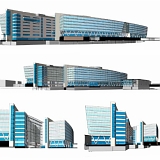
Schematic of the new NGA headquarters at the Fort Belvoir Proving Grounds, Northern Virgina. Rendering courtesy Clark Construction
Jake and I were in the Hubrismobile yesterday, watching the gunmetal sky over the gunmetal hood framed by the slick swooping windshield over the business-like German dashboard.
We were barreling down I-95 just south of Springfield and outside the Capital Beltway. Jake was eating his tuna sandwich out of the foil wrapper fresh from the Korean take-out place on the ground floor. There was no time to dine; we had an appointment, and he was just back from meetings in the corporate Head Shed up Glebe road.
That is the tower with the big corporate logo plastered on the side. People coming to meetings at our place are always mistaking the proud tower for us, because the company name is on the side. We try to maintain a much lower profile, safe and anonymous in an anonymous glass building block.
We have a lot to be anonymous about in our building. I rode up in the elevator one time with the notorious autocrat of Blackwater Security, Eric Prince, who maintained a couple suites in our building. That was before his contractual excesses caused him to flee the country. He was with a spectacular brunette, and I was at some pains to mind my own business.
That is a good policy in our building. No press releases.
That was not true about the campus we were headed for. We were bound for the old Fort Belvoir Proving Grounds and a VIP tour of a really big new building. On the way, we passed another huge building going up at Seminary road, just off the highway. “God knows who is going in there,” I said. “But it is going to completely hamburger the traffic around here.”
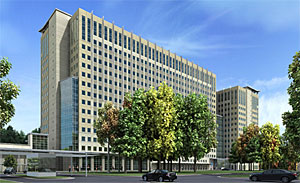
BRAC-133, just off I-395
“Washington Headquarters Services,” said Jake. “And you know what that could mean. Just about anything.”
There was no time for the tour in the business day. There never is, what with the controversy over the Federal budget, or lack of it, or the calls for the imposition of a no-fly zone over Libya or the flap over the summary dismissal of the CEO of National Public Media.
I had been working up a chart with the Libyan Air Force Air Order of Battle at home, before the business day started, but that was just going to have to wait. This tour had been scheduled weeks before, and schedules for other Flag officers coordinated, and it would have taken more time to take it off the schedule than it would to simply execute the mission.
Jake told me to swerve off the interstate at Exit 166B, and as we arced off the big road and onto the security perimeter drive I looked up in amazement. I knew the place was big, but I had no idea.
The white dome of the atrium roof soared into the low clouds, covering the space between the bulk of two towers with footprints the size of aircraft carriers.

The NGA Complex from above. Photo Clark Construction
“Supposed to be the third largest Federal Office Building in the world,” said Jake, laconically. “Only the Pentagon and the Reagan Complex downtown are bigger.”
“Jeeze,” I said. “This is huge.”
I have been around the subject of federal real estate as a condition of employment for a while. I have found if you hang around long enough, you wind up knowing the people who are actually in charge of these vast enterprises. Jake had one of the Big Three as a Director; our pal Tish is the first woman to head a Combat Support Agency, the one that is throwing this building up against the sky.
It was from a discussion in the Parking Structure of the new headquarters that the invitation had been extended in a roundabout fashion stemming from her Change of Command. Tish relieved Bob, who was a shipmate long ago, who in turn had relieved Jim, who I worked for twenty years ago, who had been responsible for approving the bold design submitted by the behemoth Clark Construction Company.
I had been a minor cog in the process that contributed to all this, which was Jim’s decision to consolidate all East Coast Operations of the National Imagery and Mapping Agency into one place. The Base Relocation and Closure round for 2005 was the vehicle, and I was a newly retired contract player in the discussion about what to do with the Intelligence Community as the War on Terror began to sprawl across the globe.
I was interested. When I was a minor functionary on the budget staff we programmed the budget that completed the big complex at Bolling Air Force Base, a $500 million project. It was endlessly fascinating to watch the money slosh across the program years. This project was the result of Jim’s decision to re-cast the mission of his agency into what he called The National Geospatial Intelligence Agency, or NGA.
Three letters are important in this town, and that, despite the four or five words, is what it was.
I wheeled the Hubrismobile into the visitor’s lot in front of the brand spanking new visitors center that serves as the gateguard for the massive complex. The parking garage loomed to the right, and the soaring towers dominated the gray sky.
We divested ourselves of cellphones, pagers, electronic media and coats and walked up to the glass doors.
In the lobby, we were joined by Tom, who was the 54th Director of Naval Intelligence. He and Jake were the VIPS, and I was content to be a horse-holder. In fact, my attention was drawn to the Protocol Officer, who was wearing a set of denim leggings that she must have known when she sprayed them on that morning constituted a weapon of mass distraction.
When the party was assembled, the Government side had two senior functionaries from NGA, Art the architect, Mylan the government project manager, a security honcho and an unidentified minder in addition to the astonishing woman from Protocol.
Art was the tour guide. He directed us to done hard-hats, safety glasses and orange safety vests for our protection on the job site. He started out on message. “As part of the larger Pentagon base realignment program, this site will consolidate local employees from about a half-dozen locations, including facilities in Bethesda, Reston, Fort Belvoir and the Washington Navy Yard. “
“I remember the first time I got to visit Building 213,” I said to Tom. “The civil war-era building was home to the beginning of satellite imagery. Is there anything here that recalls the Wild West days in SE DC?”
“We are trying,” he responded. “But first thing is to account for about nine thousand employees, who will move into the building in 35 separate moving increments. We are on round 18 right now.”
“About a third of NGA’s workers are based in St. Louis,” said Mylan. “they will not be affected by this.”
“The original concept for the campus had ten separate buildings, but the General liked the idea of having a single main building to unite the organization.”
As we trudged through the vast parking structure, controversy was already apparent and the government guys joked about parking places. The garage is only built to accommodate about five thousand cars, so having a designated parking place was clearly going to be a sign of prestige and influence.
“What did all cost?” asked Tom. There was some back and forth in response.
“On time and on budget,” said Mylan firmly.
“There are a couple numbers. A good one might be $1.7 billion,” said Art. Thoughtfully.
“Though with site prep, the visitor’s center, the data storage complex and the fire department, utility plant and remote delivery screening facility, it might run $2.4 billion,” added Mylan.
“Holy crap,” I said to Jake, sotto vocce, as we tried to access the card readers at the entrance. He smiled back.
Art said we would be taking the tunnel though the floor of the Atrium to the elevators and start the tour with the Wow Factor and work our way down again. “This is all temporary. We are in the process of getting approval from the Fairfax County’s Building Inspector to open up the space. When we do, this will be all ripped out and open to the roof eight floors above.” Gesturing us to follow a gaggle of employees unencumbered with hard hats, glasses or vests, Art waved his hands expressively. “The first two floors will be the GeoInt College.”
I was impressed already, but I had no idea about the Wow Factor, which is something one doesn’t normally associate with government projects, except maybe health care reform or the Wall Street bailout.
I will have to get to that tomorrow. This was something else.
Copyright 2011 Vic Socotra
www.vicsocotra.com
Now, for Something Completely Different
NY times: “Socotra House Launches 548th Million Irrelevant Web Site: Publishing World Sighs in Indifference.”
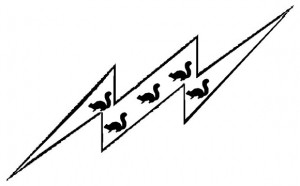
Editor’s Note:
For those who missed the Daily yesterday, the entire production staff at Socotra House Publishing expresses the deepest regret. It is not our fault. Really, we showed up for work and everything. Here is what hung us up:
Power blinked off in two orderly stages of complete degradation at Big Pink shortly before 0800, the result of an eager-beaver squirrel, if we may be permitted the mixed metaphor, who apparently found the end-of-winter hunger so profound that the little critter gnawed through the lines in the transformer located over by the intersection of Pershing and George Mason Drive.
As you know, the voltage of the electricity produced by the generators at the coal-fired plant in West Virginia, is “stepped up” before being shipped out to customers here in Arlington as alternating current (AC) in 60-cycle phases, then “stepped down” at substations and ultimately the transformer near Big Pink to become 220-volt (washer and dryers, mostly, for household applications) or 110-volt circuits (which powers the bank of servers that hum as the main engine of Socotra House Publishing).
Electrons do not move down the wires in one continuous flow directly from generators to houses. Waves of AC currents shift directions based on the RPM of the spinning of the generators. In Spring, and again in Fall, the imperatives of the little gnawing mammals periodically causes the electricity to pass directly through the squirrel, which causes the transformer to “pop” wetly and drop off-line.

Anyway, I would have invited you yesterday to visit the all-new fancy web site that will serve as the portal between the physical and virtual worlds of SHP, LLC. In our strategy to make the site survivable, a portion of our archives have been placed in a digital repository in the Inter-mountain west; our editorial suite remains located in the immediate vicinity of the National Capital Region, with satellite connectivity and broad-band access in near the vast vaults of the Mt. Pony national bomb-proof media archive.
This is very much a work in progress. Thousands of photo sets are queued up, ready to be added, and we are engaging the services of a battalion of interns to port over the archives of the last decade’s worth of stories. We are also in the process of rolling out a line of physical and e-books, t-shirts and coffee mugs.
There are no depths to which we will not sink.
This plummet into the world of crass commerce makes everyone feel a little queasy, but we will see how it goes.
As an added note, should you visit www.vicsocotra.com and see the old trusty web site, hit the “refresh” button on your browser tool-bar. The miracle of home computing is that previous images are saved on our hard drive to make them load faster from cache memory. Refreshing will access the site server for the most current version of the site.
There will be a cascade of new content and vast new opportunities for frustration and error as we build the site.
Join us on the adventure, won’t you?
Sincerely, The Editorial Staff of the Daily Socotra
Oh, the story, had it ever got written would have been titled “L’Etat C’es Moi,” some ruminations on the rantings of megalomaniacal madmen of the Maghreb, the process of preparing for the most likely contingency, and No-Fly zones you can establish in the privacy and comfort of your own home.
Maybe, squirrels permitting, we can get to that tomorrow. It will take a minute to bring up the ships, cruise missiles and associated support staff anyway.

Copyright 2011 Vic Socotra
www.vicsocotra.com
Calle 8

The Real Deal in Rio. Grazieli Massafera appears in costume at Carnival, 2008. Photo Wikicommons
Brazilian Supermodel Gisele Bundchen and her hubby, Mr Bundchen, are back in Brazil for Carnival. I saw the news while scrolling through potential destinations to park my butt for a week or two. I do not want to think about what is going to happen when the music stops and we have to pay the tab for all this lunacy.
This would have been the day the Federal Government would have started to shut down, had a last-ditch two week truce not been brokered. I have no idea what they are thinking over there on the Hill. I listen to what the talking heads say about it, and Senator Reid and Speaker Boehner, and cannot understand what they are doing.
It seems to be some sort of game of chicken, in real large bumper-cars with commentators placing the reference point at the Clinton-Gingrich show-down six years ago.
The Republicans blamed Clinton for the shutdown, as I recall, and Clinton blamed the Republicans. It seemed that public opinion favored the president; since Mr. Clinton’s approval rating rose to the highest it had been since his election. I presume that is what Mr. Obama is counting on, and is consequently egging on the Tea Party Freshmen in the House, but I don’t know.
If my business didn’t count on it, I wouldn’t mind if the government just took a break for a while and stopped printing money just to see what it is like.
I mean, we are already having a year without a budget, sort of like 1816, the year without a summer.
It will not be that this year, I am confident, and believe fully that the warmth will come again despite rising gas prices and all the rest. I think that this is going to be an excellent year. I intend to enjoy it, regardless of whether the dollar loses status as the Reserve Currency of the world and we have to settle into some reduced circumstances in the metaphoric equivalent of a trailer park down south.
They are slipping toward Fall down in Rio, not that there is much change in the weather. And oh hell, the Mister in this case is really Tom Brady, QB of the New England Patriots. As you may recall, the Pats took an early exit from the playoffs this year after posting the best regular season record in the NFL.
I envied the Bundches, who were in full party mode in Rio, sambas and masks and all the trimmings. It suddenly occured to me that I need a vacation.
I was dreaming of Brazil last night, don’t know why, but it seemed to be the prefect antidote to perpetual travels to the frozen Northland. I imagine that appeals to Mr. Bundche, who can swim in relative anonymity in a place where no one wears pads, or has any logical reason to do so.
Then it struck me that the conference next week is in Miami. That could almost be a vacation. I looked up the dates for Carnival there, and discovered that 8th Street- Calle Ocho, as the Cubans have renamed it- is possibly going to have the worlds longest conga line the night our delegation is supposed to get in. There were 198,865 people in the one that snaked around the streets in 2008.
Thank goodness the government is not shut down, or else the Bureaucrats who are sponsoring the conference would have to stay home, and we would have to miss the Cuban carnival on 8th Street. My detailed research on Defense Acquisition procedures, the subject of the meeting, indicates this is one of the world’s largest street parties.
We have had family in Miami since it was a little southern town in America, long before it became the capital of Latin America. Herold got out of the Marine for the second time after Korea, and headed south. His bride, Magpie’s sister Hazel, set up their little family and a private business catering to air conditioning, I think. I remember the visits down there in the time when Batista ruled Cuba and they spoke English on Eighth Street.
My beautiful cousins told me they realized things had really changed when Hurricane Andrew roared through and devastated the region. The traffic lights were out for weeks, and when they came back, people treated them as sort of “advisory” things, rather than “orders.”
Nothing was the same after.
It will be interesting to see it again. The last time I was in town was to visit the gigantic flagpole at the US SOUTHERN COMMAND and I don’t think I heard any music at all. Calle Ocho is supposed to spread over 23 blocks of Little Havana, with thirty stages set up at the intersections and a pulsing salsa beat.
I have been craving some merengue, you know? That, of course, and insights into what my government customers think is going to happen in a year that promises austerity.
That can come with Lent, I suppose. I had to look it up. That starts on Ash Wednesday, the day after tomorrow. I guess the timing makes as much sense as anything else these days.
Let’s dance while we can.
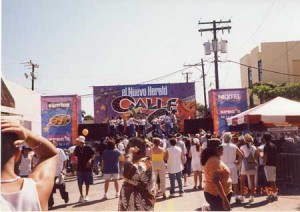
Cuban Festival on Calle Ocho. Photo DTobias at Wikicommons
Copyright 2011 Vic Socotra
www.vicsocotra.com
The Hydraulic Press
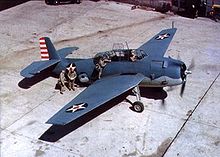
Grumman TBF Avenger Torpedo Plane, 1942. Photo Northrop-Grumman.
“Return to Raven,” read the note at the top of the page. My Dad was addressing his brother Jim Socotra, 17 years his senior, and really more father than brother to my Dad. Jim went through the same portal that Raven is going through now, long ago, and the echoes of his passing illuminate Raven’s future.
Jim wrote in the margin “Very Interesting.”
The article is un-credited, but neatly typed, with hand-written corrections and marginalia. I had been going through the deceptively neat boxes of copied family correspondence, 1963-87. It is deceptive, in that the multiplicity of post-cards and stationary is now uniformly on 9×11 sheets of copy paper, but scrambled by year and month. It is numbing work, putting it all in chronologic order; maybe not as bad as screening old home video, life in excruciating real-time, but it was pretty close.
I don’t blame Pam, the proprietor of Step Above Copying in the Little Town by the Bay for having run screaming from the task. Just spending the afternoon with all that paper trying to organize it by year was awful.
This is only the thin edge of the wedge, I thought, a whole house full of files and documents and junk. No wonder people just back the garbage truck up to their parent’s places and hire people to shovel.
Still, I was committed to copying the mass of material, burning it to disc, and sending copies back to the folks still living who had originated the hundreds of pages of documents. I have the papers in stacks now, by years from 1963 to1987, and within each year by chronological date.
I am afraid that is about as good as it is going to get. Today, I intend to fed them all into the scanner and produce data discs so that everyone in the family gets a copy to ignore misfile or pass along to brain-numbed children.
The challenge is to ignore the contents so you don’t get bogged down. One document caught my eye, though, and I had to stop in the midst of the long line of years that stretched around my office. I had just finished a marvelous and depressing book by native Detroiter Paul Clemens about the closing and salvage operation that emptied out the old Budd Company on Charlevoix St.
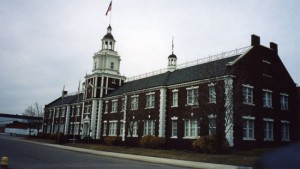
Headquarters of the former Budd Corp Stamping mill in Detroit, built in the style of Independence Hall in Philadelphia. Photo Clemens.
The book is called “Punching Out: One Year in a Closing Auto Plant,” and describes the dismantling of the stamping lines that sent the automobile parts production to new plants in Mexico, India and Brazil.
None of it stayed in Detroit, or America, for that matter. That is what made the following document so poignant, since there was a time when we really needed presses.
I remembered hearing Jim tell the story in person. He was a famous story-teller, something that I guess is a compulsion that runs in the blood. I glanced at the title, remembering.
“The Hydraulic Press. Back in the 1930’s,” the story began, and it goes from there. It is one of several dozen quite remarkable vignettes in the mass, and I thought I would share it with you. It is a story about a country that doesn’t exist any more, one that built things, and didn’t offer a “full portfolio of Financial Services.”
Come on along on a visit to a different world. It will be more fun than doing the taxes or running things through the scanner.
“Back during the ‘30s the Samson United Corp., at Rochester, made a line of heat pads, electric fans, toasters and flatirons in a big red brick building dating to the turn of the century. When World War II came along, this firm landed a big contract to build .30 caliber gun turrets for the Grumman “Avenger” torpedo plane. Not all of their factory equipment was suitable for gun-turret production, and in turn, they were in desperate need of certain tools for the turrets that they had never had for the waffle iron business.
But, with American plunged into a huge war program, many other plants also desperately need tools, too. And it took time to produce all of these suddenly-need tools, and the war plants had to make-do the best they could until they became available.
The gun turret had an aluminum ginner’s seat, a compound, contoured share reminiscent of modern fiberglass molded chair styles.
To produce this shaped seat, Samson needed a hydraulic press to form and shape the aluminum. The exigencies of war production made it impossible to stop and redesign the seat for simpler manufacture on simpler tools. Too many turrets were already in service and all seats had to be interchangeable for repair purposes. No changes, however well-advised, were permitted by the Navy Department.
Samson had to make these seats by hand, the hard way, until they could get a hydraulic press, many months away. The Company brought in a silversmith from Gorham, a real artisan, who could fashion metal into beautiful contours by beating it with a hand hammer, a painfully slow process for wartime production. They found skilled coppersmiths, too, and this little group of craftsmen tap-tapped away ‘round the clock, seven days a week, beating out the gunner’s seats but were never quite able to meet the growing production demands.”
(Ed note: The Avenger entered service in 1942, and first saw action at the Battle of Midway, where Torpedo 8 took heavy losses, but drew the IJN defending fighters away from the dive-bombers that devastated the fast carrier force. Despite losing five of the six Avengers on its debut, it survived in service to become one of the outstanding torpedo bombers of the Pacific War. Greatly modified over its service life, the Avenger remained in use until the 1960s as a fire-fighting tanker.)
“One day a grubby old broom-pushing janitor who had been a fixture around the plant for longer than anyone could remember finally made himself heard above the wails of the production managers who hovered and wept over the little band of “tin knockers,” eager to snatch each gunner’s seat the moment it could be bulldozed through Inspection.
“Why,” the old man asked, don’t you use the hydraulic press you’ve got?”
It took a little while before anyone would pay any attention to the old man but his acid comments finally culminated in a safari down into a musty and long-abandoned basement. We climbed over a filthy little of old packing cases and the junk and debris of decades of neglected housekeeping. The place was musty and damp and full of cobwebs. No lights worked, and we could hear the scuttling of rats through the debris beneath our feet as we warily followed the old janitor, squirreling ahead of us through the dank cavern.
Eventually he turned a corner, and stopped, standing in a shallow pool of dirty drain water. In the rays of our flashlights there sat- sure enough- a big hydraulic press with a platen in the middle maybe four feet in diameter. It was encrusted with rust, shoddy with neglect, and looked like something that could have come over in the Ark.
But it was, undeniably, a press.
We could not afford to be finicky. We shoveled some of the junk out of the way, got the lights working and attacked the old thing with wire wheels, steel wool, chipping hammers, and grinders. We manage to break the big piston loose of its rust and draw it out of the deep cylinder beneath eh floor. It was pretty badly rusted. Instead of a smooth piston, it had deeply rusted rings where the packing gland- made of tarred rope!- had allowed it to corrode deep grooved rings. But we shined it up and smoothed it as best we could and put it back in place with a fresh rope-gland packing.
Meanwhile, another crew tackled the pimp. The press was operated by water, not oil. Beside the press was a three-cylinder pump with three different sizes of cylinders in a row; the big low-pressure cylinder, the medium pressure vessel and the smaller high-pressure cylinder.*
These tubes were set upright like three open buckets. We had to drive the rusted pistons out of the rusted cylinders with stout hammer-blows.
The three connecting rods reached all the way to an open crankshaft mounted on the ceiling! It looked like a small edition of an old steam engine on some ancient ferryboat. But, the day came when we turned on the new motor and waited to see if the great ram would rise up out of the floor. It did, slowly. And when the first corroded ring in the piston cleared the packing gland, there was a “spat” of water and a great gush of high pressure water shot out around the piston and soaked everybody in the place and hissed off the walls.
We were a dripping mess, shocked by the unexpected immersion in cold water. But the piston crept inexorably upward, sealing itself until the next corroded groove came up through the packing gland and soaked us all again- at least those who had not taken cover.
It worked.
We had dies ready to set on the platform, and indeed, the ancient press did crunch aluminum sheets into shape, and we were in business.
What a business! We built a steel shield for the operator to hide behind against the leaks of high-pressure water. He would load the old press, turn on the water valve, switch on the motor and retire behind his barricade. He had a stack of comic books to amuse himself.
As the pump chortled and squished, and the ram groaned and spat sheets of water out, he could get through the contents of about one Captain America book before he heard the sound of crinkling metal as the form dies squeezed home. When the pump started slowing in protest and the motor groaned and smoked, he would reach out from behind his shield and flip the water valve- and pick up another comic book. For the old press opened just as slowly as it closed; there was no “high-speed” return stroke.
Seven days a week, 24 hours a day, the old press formed gunner’s seats for the torpedo planes. Visiting Naval Officers came, watched, and went away shaking their heads. The old press never ailed for seven months of use. Eventually a modern high-sped oil-hydraulic press finally arrived to take over.
And where did the old press come from? What was it doing there?
We dug and scraped the rust off the cast-maker’s emblem and traced it probably date of manufacture to about 1905, by a company long defunct. And what was it for?
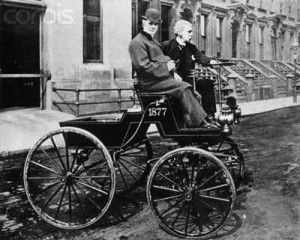
Selden Road Engine, with auto pioneer George Selden and Henry Ford at the wheel, 1895. Photo Bettman/Corbis.
It had been used, originally, to press the solid rubber tires on the wooden wagon wheels of the original Selden automobiles, made in that old plant, natch!
And with this we fought the Japs**, in World War Two.”
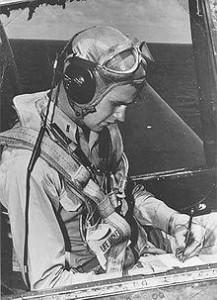
Former President and one-time youngest Naval Aviator George H.W. Bush in the seat of his Avenger Torpedo Plane in the Pacific. Seat formed at the Samson Corp, Rochester, NY. Photo USN.
* Ed note: I saw a similar arrangement on the remaining starboard powerplant of the ex-USS Olympia. The steam-plant was of the same vintage as this hydraulic press.
** Sorry, that is the way the narrator wrote it. Complain too loudly to the Greatest Generation and they might kick your ass.
Copyright 2011 Vic Socotra
www.vicsocotra.com
